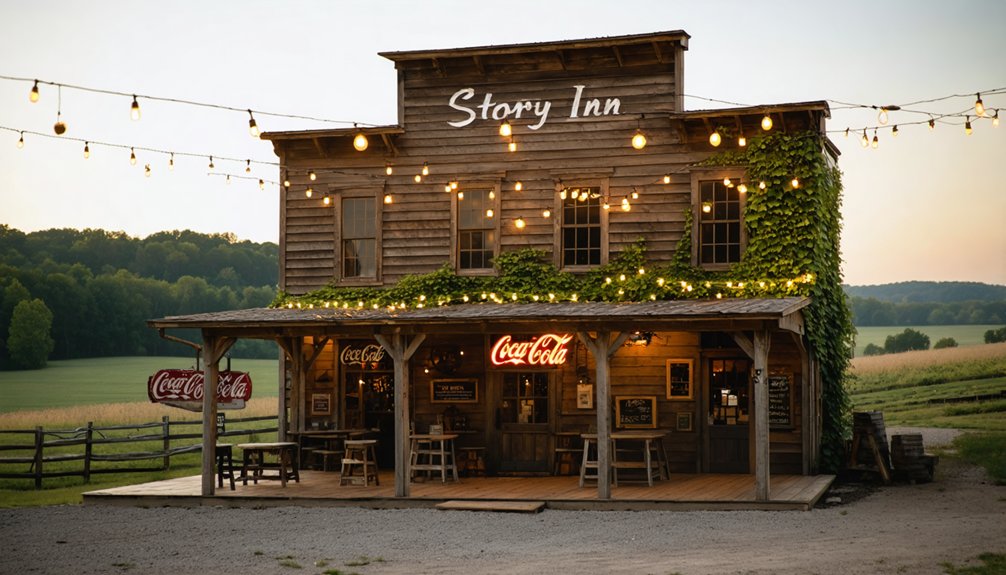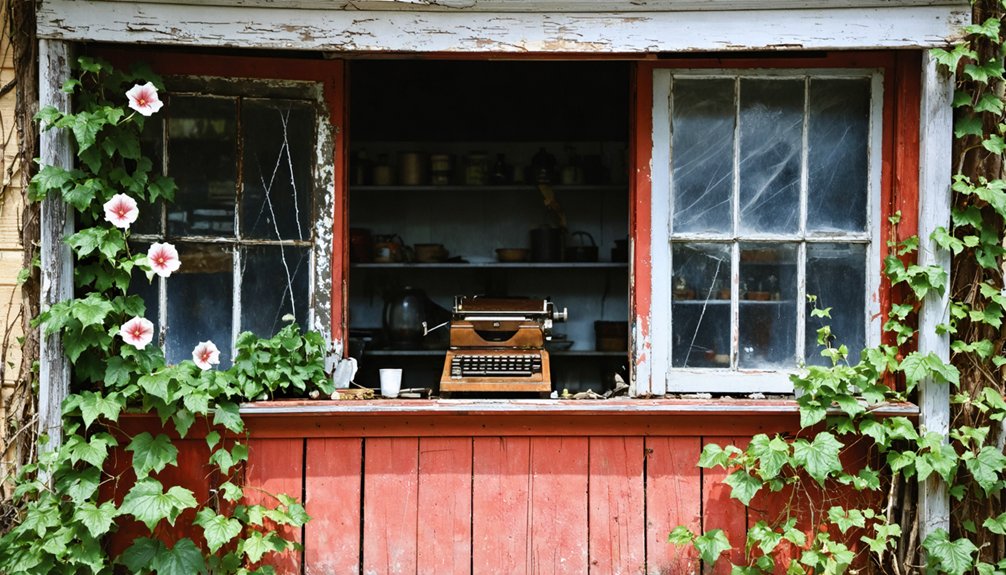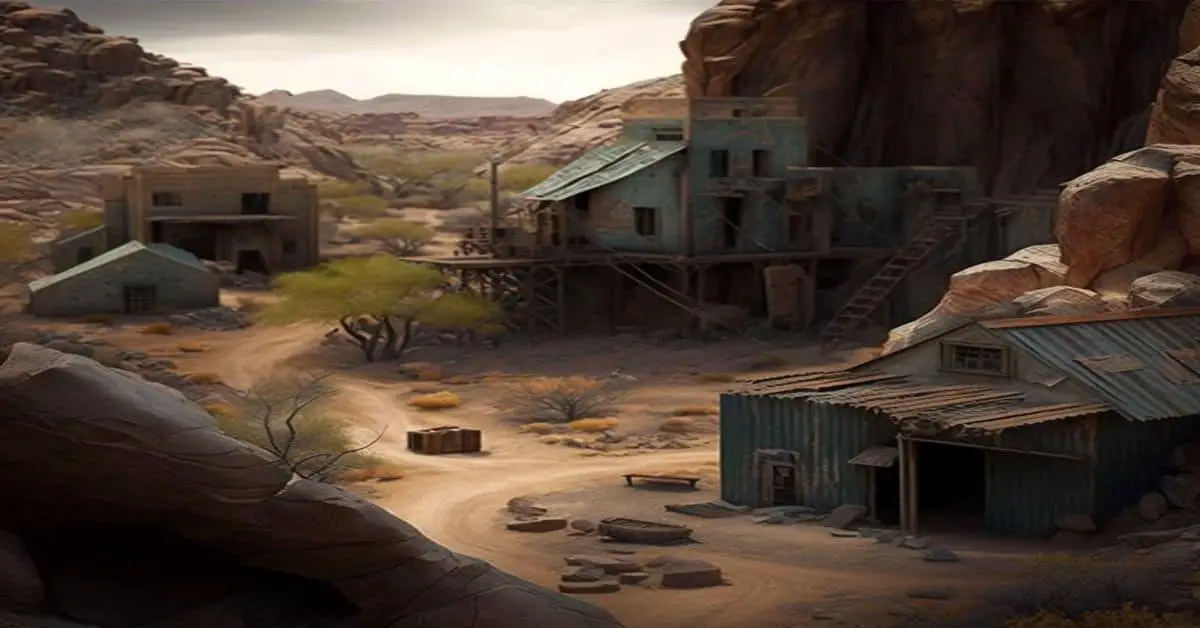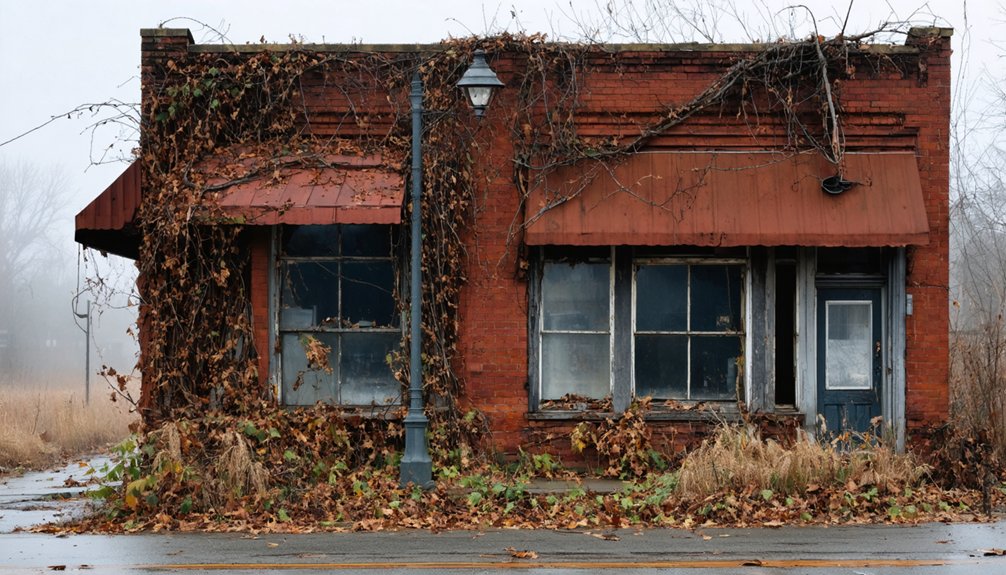You’ll find Story, Indiana tucked away in Brown County, where President Millard Fillmore granted Dr. George P. Story 173 acres in 1851. This once-thriving frontier settlement boasted sawmills, stores, and a post office before economic hardship led to its abandonment. Today, the Story Inn preserves the town’s rich heritage, offering visitors 19th-century accommodations and dining in Indiana’s best-preserved ghost town. Some say the Blue Lady, Dr. Story’s wife, still watches over her beloved village.
Key Takeaways
- Story, Indiana became a ghost town during the Great Depression when farming families couldn’t sustain themselves on the rocky terrain.
- Originally established in 1851 by Dr. George P. Story, the town was once a thriving settlement with essential services and timber-based economy.
- The town was rescued from abandonment in 1999 when Rick Hofstetter and Frank Mueller purchased it at auction and began restoration efforts.
- Story Inn now operates as a preserved 19th-century village, featuring historic accommodations, an award-winning restaurant, and the original general store.
- The town is reportedly haunted by the Blue Lady, believed to be Dr. Story’s wife, who appears in the Garden Room with scents of cherry tobacco.
The Legacy of Dr. George P. Story’s Vision
When President Millard Fillmore granted Dr. George P. Story 173 acres of Indiana wilderness in 1851, he couldn’t have known how this physician’s vision would shape the region.
Dr. Story’s leadership transformed untamed land into a vibrant settlement, originally called Storyville.
Through determination and foresight, Dr. Story shaped raw wilderness into a flourishing community that would bear his name.
Drawing from his family’s background in medicine and lumber, Dr. Story built more than just a town – he created a self-sufficient community.
You’ll find his influence in every corner of the settlement’s design, from the hardwood buildings he constructed to the essential services he established.
His community vision included a church, school, general stores, mills, and a post office.
The area’s hilly and rocky terrain made farming particularly challenging for early settlers.
The doctor’s own home, which still stands today as an inn, represents the cornerstone of his ambitious plan to build a thriving rural haven.
Today, this historic site in Van Buren Township sits just an hour south of Indianapolis, preserving the legacy of its visionary founder.
From Logging to Local Commerce: A Town Takes Shape
Though Dr. Story’s initial settlement laid the foundation, it was the region’s rich hardwood forests that truly shaped the town’s early development. The timber trade quickly became Story’s economic backbone, with logging techniques evolving to meet growing demands for construction materials and fuel.
You’d find bustling sawmills transforming massive logs into lumber, while skilled craftsmen worked the wood into everything from furniture to wagon wheels. During this time, the Story Inn building was constructed, which still stands today as a testament to the town’s prosperous era. Similar to Milk’s store complex, the town developed a thriving retail district that served the growing community.
The town’s strategic location near transportation routes helped establish it as a crucial hub for commerce and trade.
Local infrastructure expanded rapidly, with two general stores, a grist mill, and a blacksmith’s forge serving both residents and surrounding farms.
The post office’s establishment in the 1880s officially put Story on the map, cementing its position as the area’s primary commercial center.
Daily Life in a 19th Century Frontier Settlement
You’d find early settlers confronting stubborn rocky soil as they carved farmland from Indiana’s wilderness, often spending years removing stones before crops could flourish.
Your success would depend heavily on the strong bonds formed with neighboring families, who’d gather for barn raisings and share tools during harvest seasons.
Trading surplus crops, handmade goods, and labor with nearby homesteads wasn’t just about survival – it created lasting community ties that helped settlements thrive despite the harsh conditions.
Visitors today can experience authentic frontier life through hands-on activities at living history museums, participating in traditional crafts and tasks just as settlers once did.
Farming Against Rocky Terrain
Despite the fertile promise of Indiana’s frontier lands, settlers faced intimidating challenges when transforming rocky, uneven terrain into productive farmland. You’d need tremendous determination to tackle the backbreaking work of clearing stones and preparing soil before you could even think about planting.
- You’d start by adapting planting methods to local conditions, creating ridge and furrow patterns to manage drainage.
- You’d pile soil and add organic matter to improve clay-heavy areas.
- You’d manually remove rocks and obstacles, sometimes taking weeks to clear a single field.
- You’d carefully plot your rows in checkered patterns for efficient cultivation between crops.
The demanding work shaped farming techniques unique to Indiana’s frontier, where success meant mastering both the land’s challenges and innovative planting approaches that would sustain your family’s future. These agricultural methods were similar to ancient indigenous practices that had been used successfully in the region for centuries before European settlement. The practice of crossing out corn, as documented in William Medsker’s journal, became a vital technique for controlling weeds and ensuring crop survival.
Community Bonds Through Trade
Life on the Indiana frontier revolved around the bustling trading posts that served as crucial community hubs in the early 1800s. You’d find settlers and Native Americans engaging in barter relationships, exchanging deerskins and pelts for European manufactured goods like steel tools, blankets, and ammunition. The federal government established these posts to ensure fair market prices for Native traders.
These weren’t just places of commerce – they fostered significant cultural exchanges between diverse groups. Government-appointed Factors oversaw trade at these posts while being prohibited from conducting personal business.
The trading post’s credit system let you acquire necessary supplies even when cash was scarce. You could trade beeswax, animal skins, or promise future goods to obtain the tools you needed.
These economic bonds helped maintain peace between settlers and indigenous peoples, as both communities relied on the steady flow of trade. The post became your connection point for news, social gatherings, and strengthening community ties through shared commerce.
The Slow Fade: Economic Hardship and Abandonment
You’ll find few places that better exemplify economic devastation than Gary, Indiana, where U.S. Steel’s collapse in the 1970s triggered an exodus of 60% of the city’s residents.
If you’d visited ZIP code 46402 recently, you’d see the haunting results: nearly one-third of properties stand vacant, with a median home value of just $54,500.
When families couldn’t find work, they didn’t just leave their jobs – they left behind entire neighborhoods, creating vast stretches of abandoned homes that nature slowly reclaims.
Once celebrated as America’s steel production powerhouse, Gary Works employed over 16,000 workers by the 1920s and stood as the largest steel plant in the nation.
Depression’s Devastating Toll
While Story, Indiana never boasted more than 175 residents at its peak, the Great Depression delivered a crushing blow that accelerated the town’s decline into near abandonment.
The depression impacts rippled through every aspect of daily life, transforming this once-vibrant community into a shell of its former self.
- Farming families couldn’t sustain themselves on the challenging rocky terrain.
- Local businesses shuttered as cash became scarce and trade dwindled.
- Community disintegration accelerated as neighbors left to seek opportunities elsewhere.
- Remaining infrastructure fell into disrepair without resources for maintenance.
The town’s isolation, already challenging due to its location, became more pronounced as the economic crisis deepened.
Families Forsake Their Land
The steady exodus of Gary’s residents mirrors the earlier struggles of Story, but on a far greater scale.
You’ll find entire neighborhoods where family migration has left a haunting landscape of abandoned homes and empty streets. As skilled workers and young professionals flee in search of opportunities, they’re leaving behind more than just buildings – they’re abandoning generations of community ties.
This wave of land abandonment creates a devastating cycle: as families move out, property values plummet and city services decline.
You can see how each vacant home becomes a symbol of lost hope, dragging down nearby properties and encouraging more residents to leave. The city’s once-proud middle class continues to shrink, while those who remain watch their community’s social fabric slowly unravel in this modern exodus.
A Modern Renaissance: The Story Inn’s Revival

Since acquiring Story at auction in 1999, Indianapolis attorney Rick Hofstetter and German restaurateur Frank Mueller have transformed this historic Indiana village into a thriving destination.
Their inn restoration efforts have preserved the town’s cultural heritage while creating a sustainable business model that keeps history alive.
You’ll discover Story’s renaissance through:
- Restored historic homes offering authentic 19th-century overnight accommodations
- An award-winning restaurant complex featuring upscale dining and a cellar bar
- A preserved general store now serving as a charming gift shop
- The famous Blue Lady Room, where paranormal enthusiasts document ghostly encounters
Today, you can experience Indiana’s best-preserved 19th-century village while supporting its continued preservation through the Story Inn’s 1851 Club membership programs, ensuring this slice of American history endures for future generations.
The Blue Lady and Other Tales From Beyond
Among Story Inn’s most enchanting features stands its resident spirit, known simply as the Blue Lady.
You’ll find her presence most strongly in the Garden Room, now called the Blue Lady Room, where countless guests have documented their paranormal encounters with the mysterious apparition.
She’s believed to be the wife of Dr. George Story, the town’s founder, and she makes her presence known through the distinctive scent of cherry tobacco and appearances in flowing blue or white robes.
If you’re feeling brave, you can try summoning her by switching on the blue light in her room.
Over decades, visitors have reported unexplained phenomena, from mysterious blue objects appearing to glimpses of her hypnotic blue eyes.
The Story Inn’s guestbooks overflow with firsthand accounts, making this one of Indiana’s most well-documented hauntings.
Frequently Asked Questions
What Were the Typical Wages for Workers in Story During Its Peak?
You’d have found wage history varied during Story’s peak, with laborers earning $0.50-$1.50 daily and skilled craftsmen making $1.50-$2.50, while economic conditions allowed seasonal workers to earn $20-$30 weekly.
How Did Children Travel to School During Harsh Indiana Winters?
Through bone-chilling blizzards, you’d bundle up in winter gear and brave snowy commutes via horse-drawn “kid hacks,” walk miles to one-room schoolhouses, or catch motorized school buses that emerged in early 1900s Indiana.
Were There Any Notable Crimes or Lawless Incidents in Story’s History?
You won’t find any significant crime incidents in Story’s history. The small, rural community maintained peaceful living with basic law enforcement, keeping its reputation as a tranquil destination for visitors.
What Native American Tribes Originally Inhabited the Story Area?
As ancient as the hills themselves, the Delaware and Miami Native tribes called this land home, with their cultural heritage deeply rooted in the forests and valleys you see today.
Did Story Have Its Own Local Newspaper or Newsletter?
You won’t find evidence of local journalism in Story’s historical archives. While residents shared news through the post office and general store, no records indicate the town maintained its own newspaper or newsletter.
References
- https://lostinthestates.com/story-indiana/
- https://allthatsinteresting.com/story-indiana
- https://money.com/indiana-town-for-sale/
- https://www.hauntedrooms.com/indiana/haunted-places/haunted-hotels/the-story-inn-nashville
- https://www.indianahauntedhouses.com/real-haunt/story-inn.html
- https://www.wrtv.com/news/local-news/whats-the-story-behind-story-indiana
- https://emptynesterstraveling.blog/2023/04/23/a-ghost-in-indiana-the-blue-lady-of-the-story-inn/
- https://www.visitindiana.com/blog/post/story-indiana/
- https://www.courierpress.com/story/news/local/southwest-indiana/2016/02/12/story-indiana-has-a-story-to-tell/86964312/
- https://www.mentalfloss.com/article/579398/entire-town-of-story-indiana-for-sale



